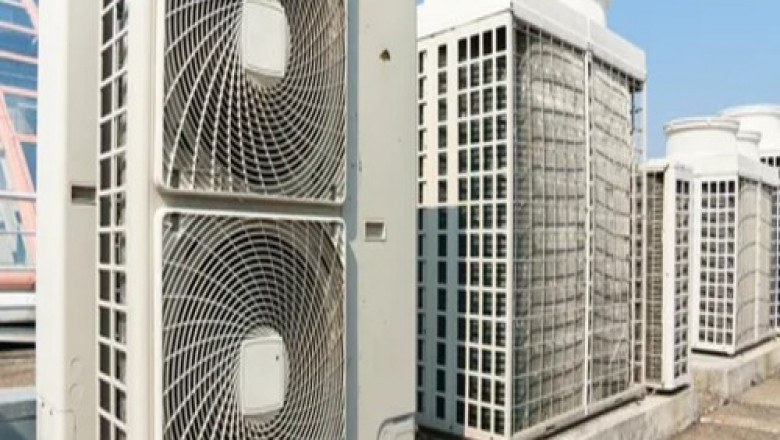views
What are VRF Systems?
Variable refrigerant flow (VRF) systems, also known as variable refrigerant volume (VRV) systems, are a type of HVAC system popular in commercial buildings as well as some residential spaces. With VRF technology, a single outdoor condensing unit will power multiple indoor fan coil units or air handling units. The key advantage of these systems is the ability for the condensing unit to modulate its capacity based on the individual requirements of each indoor unit.
How VRF Systems Work?
A typical VRF Systems is consists of an outdoor condensing unit and multiple indoor units connected via refrigerant piping. The outdoor unit contains a multi-circuit variable speed compressor, which can adjust its output to meet the varying cooling or heating needs of the indoor units. Refrigerant lines transport both vapor and liquid refrigerant between the outdoor unit and indoor units.
Each indoor unit contains a refrigerant-to-air heat exchanger with either cooling or heating thermal elements. The indoor units also have fans that circulate air across the heat exchanger. Electronic expansion valves at each indoor unit allow the flow of refrigerant to be controlled precisely to match the load.
During cooling operation, the compressor in the outdoor unit pressurizes and condenses the refrigerant. Liquid refrigerant then passes through the outdoor unit and into the indoor unit refrigerant lines. An expansion valve at the indoor unit meters the liquid refrigerant flow. This causes the refrigerant to vaporize, absorbing heat from the indoor space in the process. The low-pressure gas is then returned to the outdoor unit to be compressed again.
Heating works on the same vapor-compression cycle principle except the indoor and outdoor functions are reversed. The high-pressure liquid refrigerant releases heat as it expands at the indoor unit, warming the space. Vapor refrigerant is then returned to the outdoor unit to be compressed and condensed again.
Key Benefits of VRF Systems
One of the major benefits of VRF systems compared to conventional HVAC systems is the ability to modulate cooling or heating capacity based on the Load. This precise capacity control minimizes energy use. Unlike conventional systems that operate at a single fixed speed, VRF compressors can ramp speeds up or down in small increments based on the real-time demands of the indoor units.
Another advantage is the ability to connect varying sized indoor units to the same VRF outdoor unit for zoning flexibility. So a single outdoor unit can service multiple indoor units with varying capacity requirements. This makes VRF technology well suited to buildings with varying or irregular cooling/heating needs in different zones.
VRF systems also allow for simultaneous cooling and heating operation. So different indoor units on the same system can operate in heating or cooling mode independently based on the space needs. This capability provides better occupant comfort compared to traditional all-or-nothing systems.
From an installation perspective, VRF systems require less pipework and wiring than equivalent multi-split systems. They are also more compact with the condensing unit located outside and thin refrigerant piping supplying the indoor units versus bulky refrigerant pipes. This makes VRF technology well suited to retrofit projects where space is constrained. Maintenance of VRF systems is also simplified compared to dual-duct or water-based systems.
Control and Energy Monitoring Capabilities
Modern VRF equipment comes equipped with advanced control and monitoring features. Smartphone apps and building automation systems allow for remote monitoring and control of key system functions. Some advanced VRF units also incorporate occupancy sensors to optimize operation based on space usage.
Integrated energy monitoring capabilities provide ongoing diagnostics of system performance to maximize efficiency. Data logging examines variables like compressor run times, indoor unit demand, and outdoor ambient conditions. This gives building operators insights to implement fine-tuned control strategies that minimize energy consumption over time. Alarm notifications also alert to maintenance needs before significant issues arise.
Applications for VRF Technology
Given the aforementioned attributes, VRF systems have become increasingly popular for commercial and light industrial HVAC applications. They are suited to buildings with varying or irregular cooling/heating needs such as:
- Office buildings with multiple private offices and open floor plates
- Retail stores with sales areas requiring both heating and cooling
- Hotels with guest rooms and common areas with fluctuating occupancy
- Healthcare facilities with precisely controlled temperature zones
- Educational buildings with classrooms and lecture halls of different capacities
- Mixed-use developments with residential above commercial spaces
VRF technology offers designers flexibility on indoor unit layout and overall system sizing. The ability to right-size to actual building loads also makes VRF an energy efficient solution. This has led to broader adoption of VRF technology across commercial construction in recent years.
In the variable refrigerant flow systems deliver precise temperature control, zoning capabilities, simultaneous heating/cooling operation, energy savings, and installation benefits over conventional HVAC solutions. When properly designed and maintained, VRF technology provides high performance HVAC for both commercial and some residential applications.
Get This Report in Japanese Language: VRFシステム
Get This Report in Korean Language: VRF 시스템
About Author:
Vaagisha brings over three years of expertise as a content editor in the market research domain. Originally a creative writer, she discovered her passion for editing, combining her flair for writing with a meticulous eye for detail. Her ability to craft and refine compelling content makes her an invaluable asset in delivering polished and engaging write-ups.
(LinkedIn: https://www.linkedin.com/in/vaagisha-singh-8080b91)






















Comments
0 comment